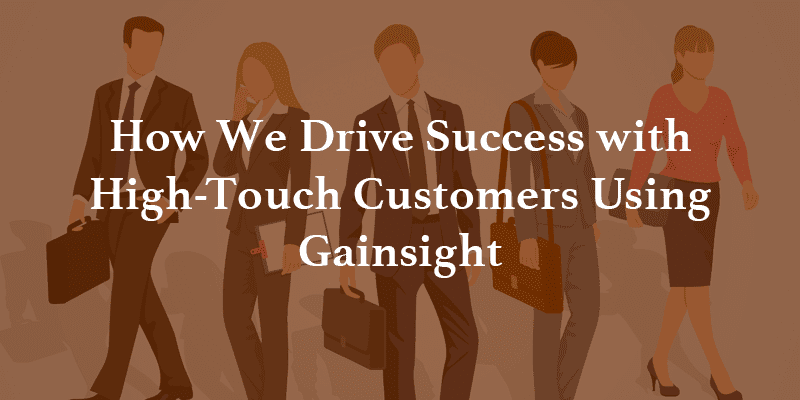By Shirley Amsterdam, Business Operations Manager, and Noha Khan, Business Operations Analyst at Gainsight
At Gainsight, we’ve divided our customer base into four segments based on key attributes. You can read more about our approach to segmentation in this recent blog post by Allison Pickens, VP of Customer Success and Business Operations. One of our segments is focused on large enterprises with high ARR or high potential ARR that require proactive, high-touch engagement. Therefore, we created a separate team to engage with them, defined tailored goals and developed a dedicated high-touch lifecycle journey.
In this post, we’ve documented the steps we took to create and operationalize an optimal lifecycle journey for our high-touch customers.
Step #1: Define the lifecycle journey
Developing a lifecycle journey that is tailored to each customer segment may seem an overwhelming exercise at first; nevertheless, it’s a critical factor to drive success. To help you get started, here is a quick guide with 5 key steps:
- Define success: Quantitatively, what are the goals for the post-sales organization for this segment? Once we aligned on what success looks like, we started developing the right processes to execute. Read more about our metrics definition thinking here.
- Start with segmentation: The customer journey starts with defining the segment (e.g. SMB, mid-market, enterprise) and the respective touch model (e.g. tech touch, mid-touch, high touch). Define for which customers we are crafting our lifecycle.
- Define key phases: The next step is defining the key phases the customer goes through (e.g. Pre-Sale, Onboarding, Adoption, Growth). Then, break down each phase into sub-stages (e.g. “Welcome” stage as part of Onboarding). It’s important here to align the stages across segments so that reporting and measurements can be driven across the portfolio.
- Identify critical stakeholders: For each phase, identify the key stakeholders you’ll need to engage with. Ask yourself, who are the key contacts that we need to interface with?
- Brainstorm key touch points and activities: This is where the magic happens! After you’ve outlined the various stages and identified the key stakeholders, formalize key touchpoints to engage with each stakeholder (e.g. Executive Business Reviews).
- Prioritize “Moments of Truth”: There are interactions where the stakes are higher. For instance, when you check into a hotel, does reception know who you are, have your reservation ready, room available and WiFi code? Superb handling of these moments can leave lasting impressions and are critical for long-term success. So, after you brainstorm various touch points, prioritize which ones will address such “Moments of Truth” (e.g. kickoff call, first EBR).
After we went through these steps, we had a high-level perspective on the key stages and touchpoints. The next step was to break it down further to specific activities and later detailed Playbooks and CTAs to execute on each touch point.

Step #2: Outline the customer experience to adopt a customer-centric mindset
For each step along the lifecycle, we thought through what we want our customers to feel and that informed the key activities and responsibilities our team executes on. For example:
- In Pre-Sale, we want our customers to know that Gainsight understands their business needs and can solve their challenges. Therefore, we provide a value workshop and ensure the Client Outcomes Manager is involved and provides strategic consultation.
- In Onboarding, we want our customers to feel confident in the implementation process so we conduct an initial exec alignment meeting and other exec check-ins.
- During the Adoption phase, we want our customers to feel like Gainsight has added value to their business. This is why we conduct strategy sessions, EBRs and other key meetings with each stakeholder to monitor adoption and demonstrate value.
Step #3: Operationalize the lifecycle using Gainsight
After outlining the lifecycle journey, we’ve operationalized it in Gainsight:
- CTAs: We created CTAs to execute on each touchpoint. For example, when a new high-touch customer begins their journey, a Rule is triggered to assign CTAs to the relevant Client Outcomes and Onboarding team members to welcome the customer and later set an exec alignment meeting. Similarly, prior to Launch, a CTA to set a Pre-Launch EBR is triggered. On an ongoing cadence during Adoption an Executive Business Review and Executive Check-In CTAs will be triggered. Once completed these will be recorded as Milestones and be tracked via Reports.
- Playbooks: We developed Playbooks with detailed tasks and clear timeline for each touch point. Select examples below with links to similar Playbooks on Gainsight Vault:
- Pre-Sales
- Pre-close meeting where Sales introduces Client Outcomes and Onboarding team members
- Internal handoff from Sales to Post-Sales
- Onboarding:
- Welcome to Gainsight
- Initial Executive Alignment during Onboarding to align on strategic priorities
- Launch Preparation and Execution
- Training & Preparation to Adopt
- Adoption:
- Executive Business Reviews
- Advocacy programs
- Technical Success Services offerings
- Growth:
- Provide internal weekly updates on customers’ status and recent events
- Document significant emails, calls and meetings
- Create a draft agenda prior to meetings
- Take notes during meetings (and enjoy the auto-save functionality!)
- Improve new owner ramp-up. Timeline provides an easily digestible history with rich context to get the new owner up-to-speed.
- Provide visibility to management on the customer’s history prior to executive meetings
- Improve cross-functional visibility when having several owners from various teams working with the customer (e.g. CSMs, Onboarding, Sales)
- Identify key priorities, pain points and opportunities to deliver value
- Create an exec-level view of the customer’s goals and a corresponding project plan, and share it with the customer in a PPT format
- Track the value delivered with key stakeholders and executives
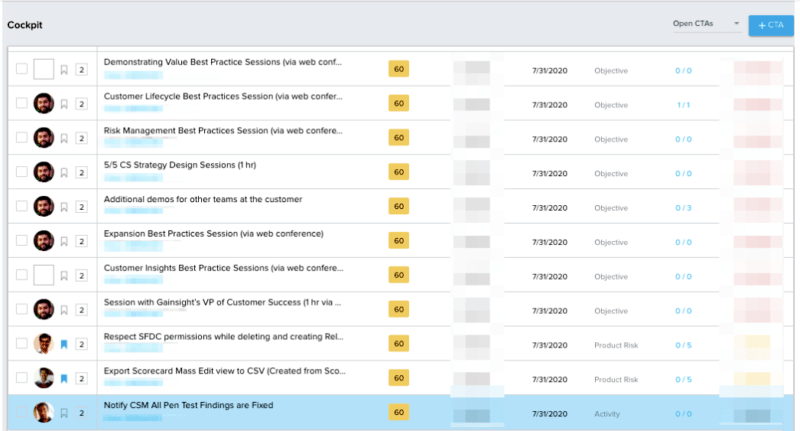
Step #4: Leverage Timeline, Success Plans and Email Assist
To drive success with our high touch customers, we made sure that at each stage – from Pre-Sales to Onboarding, to Adoption and finally to Growth – we stay engaged with the customer every week. To ensure such frequent interactions are managed optimally, we leverage C360 Timeline, Success Plans and Email Assist.
4.1 Track Customer Interactions with C360 Timeline
The new C360 Timeline provides a centralized place to record events and notes. Timeline provides an intuitive interface to capture and digest key customer-related activities. We, at Gainsight, use Timeline to:
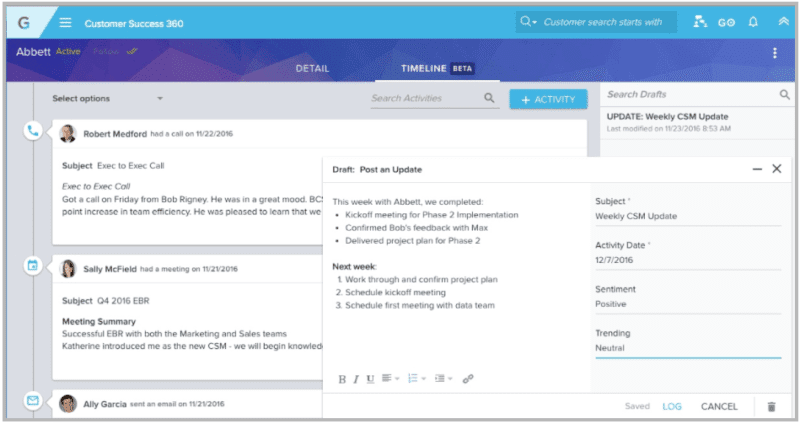
4.2 Evaluate and Monitor Success with Gainsight “Success Plans”
Success Plans drive strategic and proactive customer engagement by helping to:
Success Plans are comprised of Objectives. For a high touch account, we track progress towards these Objectives, monitor completion of tasks and evaluate success with the customer every quarter.
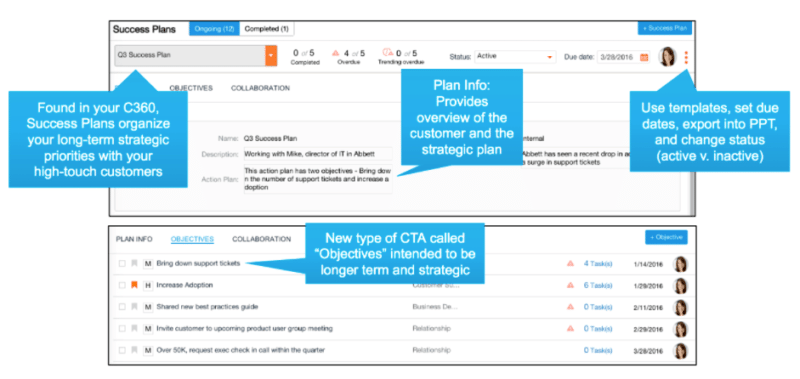
As part of our high touch lifecycle, we conduct a Strategy Session, ideally onsite with key stakeholders, where we align with the customer on top priorities. In our follow up to that meeting, we create a Success Plan documenting these top priorities and a timeline. We leverage Success Snapshots to export the plan into a PPT to align with the customer, and later to track progress during quarterly Executive Business Reviews. We also use reports to monitor completion on an ongoing basis or even review the Success Plan screen live in regular meetings.
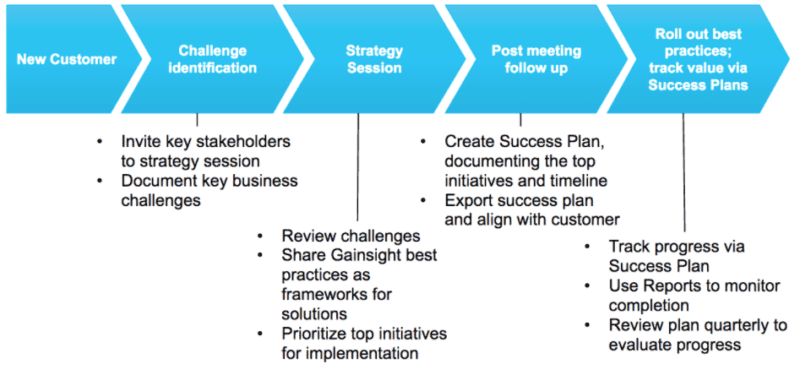
4.3 Share Best Practices and Product Updates Efficiently with “Email Assist”
An important success factor with high touch customers is sharing best practices and acting as a trusted thought partner.
With “Email Assist”, high touch CSMs can aggregate their best practices emails for common situations into a Playbook and send it from Cockpit at the right time with the right personalized messaging, instead of creating such emails from scratch every time.
Also, CSMs can send periodic product updates and tips in a proactive and scalable manner, while positioning themselves as knowledgeable advisors.
